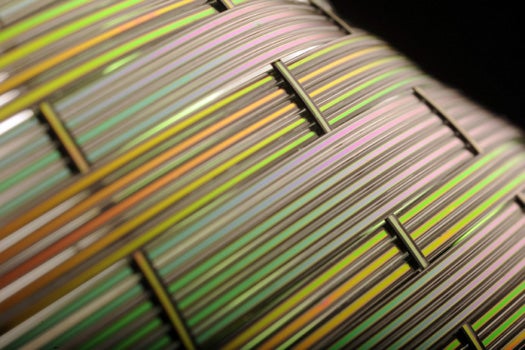MIT’s New Multifunctional Fibers Combine Piezoelectric Sensitivity with Heat and Light Sensing
Mashing together optical fiber technology and piezoelectrics, MIT scientists have developed a new kind of multifunctional material that can not...

Mashing together optical fiber technology and piezoelectrics, MIT scientists have developed a new kind of multifunctional material that can not only carry and modulate light, but can sense or create pressure changes in the material, layering additional sophistication onto already complex materials. The fibers could be used to create smart textiles that monitor the body, structural sensors that detect even the smallest stresses on a structure, or biomedical devices that could be tucked into the tightest corners of the human body.
The MIT team, headed by professor of materials science and engineering Yoel Fink, has previously cobbled together heat sensitive and light sensitive materials, but adding piezoelectric functionality to these fibers adds a whole new dimension, giving materials the ability to convert mechanical changes in shape to electrical signals and vice versa.
But making these properties work together presents a particular challenge. In order to make their previous heat- and light-sensitive materials, Fink and company devised a method of layering the necessary materials into a thick “perform” cylinder that is then heated and stretched into a long, thin fiber. All these materials — polymers, metals, etc. — have to melt and stretch at similar temperatures. To make a piezoelectric layer, they had to do the same thing, mixing and matching polymers and polycarbonates to get a material that would heat and stretch uniformly and still retain its crystalline piezoelectric structures.
But after combining the earlier materials with the piezoelectric layer, the team now has a finished fiber that carries light as well as electricity. Vibrations or pressure generate an electrical signal, while electrical signals can be used to elicit mechanical changes in the fiber or cause vibrations that in turn can even be turned into acoustic waves.
Such materials could be used to perform a variety of tasks, not least of which is to monitor bodily functions via very tiny biosensors. The less-than-one-micrometer-wide fibers could be inserted into organs or the cardiovascular system to monitor for biomarkers or blood flow, while their ultrasound-like ability to perform acoustic sensing and carry infrared light essentially makes them tiny ultrasound imagers.